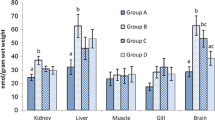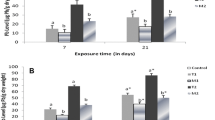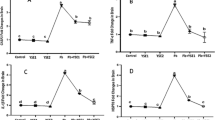Abstract
The present invivo study was designed to elucidate the toxic effect of lead on oxidative stress, Na+K+ATPase and mitochondrial electron transport chain activity of the brain of Clarias batrachus. The fish were exposed to 10 and 20% of the derived 96 h LC50 value, 37.8 and 75.6 mg L−1, respectively, and sampled on 20, 40 and 60 days. Exposure of fish brain to lead demonstrated an increased production of reactive oxygen species, increased lipid peroxidation, loss of protein thiol groups in synaptosomal fraction with the decreased activity of Na+K+ATPase, partial inactivation of mitochondrial electron transport chain activity and energy depletion. However, no change in protein carbonyl content in synaptosomal fraction was observed due to lead exposure. Concluding the results of our investigation we suggest that lead exposure induces oxidative stress in the brain of Clarias batrachus and the decline in Na+K+ATPase activity was presumeably mediated by the combined action of lipid peroxidation and deficient mitochondrial electron transport chain activity.




Similar content being viewed by others
References
Bennet C, Bettaiya R, Rajanna S, Baker L, Yallapragada PR, Brice JJ, White SL, Bokara KK (2007) Region specific increase in the antioxidant enzymes and lipid peroxidation products in the brain of rats exposed to lead. Free Radic Res 41:267–273
Chen L, Yang XQ, Jiao H, Zhao B (2003) Tea catechins protect against lead induced ROS formation, mitochondrial dysfunction and calcium dysregulation in PC12 cells. Chem Res Toxicol 16:1155–1161
Cohen G, Farooqui R, Kesler N (1997) Parkinson disease: a new link between monoamine oxidase and mitochondrial electron flow. Proc Natl Acad Sci USA 94:4890–4894
Dreiem A, Gertz CC, Seegal RF (2005) The effects of methyl mercury on mitochondrial function and reactive oxygen species formation in rat striatal synaptosomes are age-dependent. Toxicol Sci 87:156–162
Ercal N, Gurer-Orhan H, Aykin-Burns N (2001) Toxic metals and oxidative stress. Part 1. Mechanisms involved in metal-induced oxidative damage. Curr Top Med Chem 1:529–539
Finney DJ (1971) Probit analysis. Cambridge University Press, London, UK, pp 333–337
Flora GJ, Seth PK (2000) Alterations in some membrane properties in rat brain following exposure to lead. Cytobios 103:103–109
Flora SJ, Pande M, Mehta A (2003) Beneficial effect of combined administration of some naturally occurring antioxidants (vitamins) and thiol chelators in the treatment of chronic lead intoxication. Chem Biol Interact 145:267–280
Habeeb AFSA (1972) Reaction of protein sulphydryl groups with Ellman’s reagent. Methods Enzymol 25:457–464
Halliwell B, Gutteridge JMC (1989) Free radical in Biology and Medicine, 2nd edn. Oxford University Press, Oxford, England
Hatefi Y (1978) Preparation and properties of NADH: ubiquinone oxidoreductase (complex I) E.C.1.6.5.3. Methods Enzymol 53:11–15
Hays AM, Lantz RC, Witten ML (2003) Correlation between invivo and invitro pulmonary responses to jet propulsion fuel-8 using precision cut lung slices and a dynamic organ culture system. Toxicol Pathol 31:200–207
Levine RL, Garland D, Oliver CN (1990) Determination of carbonyl content in oxidatively modified proteins. Methods Enzymol 186:464–478
Mallik BN, Adya HVA, Faisal M (2000) Norepinephrine stimulated increase in Na+K+ATPase activity in the rat brain is mediated through alpha 1A adrenoreceptor possibly by dephosphorylation of the enzyme. J Neurochem 74:1574–1578
Miyake H, Kadoya A, Ohyashiki T (2003) Increase in molecular rigidity of the protein cooperation of brain Na+K+ATPase by modification with 4-hydroxy-2-nonenal. Biol Pharm Bull 26:1652–1658
Ohkawa H, Ohishi N, Yagi K (1979) Assay for lipid peroxides in animal tissues by thiobarbituric acid reaction. Anal Biochem 95:351–358
Pande M, Flora SJ (2002) Lead induced oxidative damage and its response to combined administration of alpha-lipoic acid and succimers in rats. Toxicology 177:187–196
Patrick L (2006) Lead toxicity part II: the role of free radical damage and the use of antioxidants in the pathology and treatment of lead toxicity. Altern Med Rev 11:114–127
Rogers JT, Richards JG, Wood CM (2003) Ionoregulatory disruption as the acute toxic mechanism for lead in the rainbow trout (Oncorhynchus mykiss). Aquat Toxicol 64:215–234
Skerfving S (1988) Biological monitoring of exposure to inorganic lead. In: Clakson TW, Freiberg L, Nordberg GF, Sager RR (eds) Biological monitoring of toxic metals. Plenum Press, New York, pp 169–197
Spokas EG, Crivellone MD, Kemp F, Bogden JD, Cohen GM (2002) Characterization of Sodium, Potassium, ATPase Activity in the Gills of Pimephales promelas (Fathead Minnow): influence of In Vitro Exposure to Lead. Bull Environ Contam Toxicol 69:384–392
Valverde M, Fortoul TI, Diaz-Barriga F, Mejia J, Castillo ER (2002) Genotoxicity induced in CD-1 mice by inhaled lead: differential organ response. Mutagenesis 17:55–61
Wharton DC, Tzagoloff A (1967) Cytochrome oxidase from beef heart mitochondria. Methods Enzymol 10:245–250
Zamai TN, Titova NM, Zamai AS, Usoltseva OS, Yulenkova OV, Shumkova DA (2002) Effect of alcoholic intoxication on water content and activity of Na+K+ATPase and Ca-ATPase in rat brain. Bull Exp Biol Med 134:541–543
Acknowledgments
The authors thank the Principal, Jhargram Raj College along with Head, Department of Zoology (Post Graduate), Jhargram Raj College, West Bengal, India, Pin – 721507 and Head, Department of Physiology, University of Kalyani, West Bengal, India, Pin-741235 for providing necessary permission and laboratory infrastructure for carrying out the entire research work. The authors are thankful to Dr D Mazumdar, Head, Department of Agricultural Statistics, Bidhan Chandra Krishi Vidyalaya, West Bengal, India for extending useful suggestions in statistical analysis.
Author information
Authors and Affiliations
Corresponding author
Rights and permissions
About this article
Cite this article
Maiti, A.K., Saha, N.C. & Paul, G. Effect of Lead on Oxidative Stress, Na+K+ATPase Activity and Mitochondrial Electron Transport Chain Activity of the Brain of Clarias batrachus L.. Bull Environ Contam Toxicol 84, 672–676 (2010). https://doi.org/10.1007/s00128-010-9997-9
Received:
Accepted:
Published:
Issue Date:
DOI: https://doi.org/10.1007/s00128-010-9997-9




